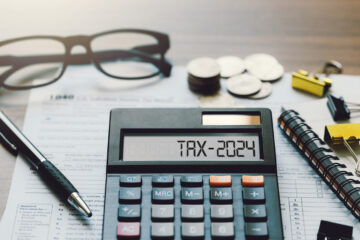Photo taken by Anna Song: A café in the Marais in January. (Figure 1)
Nashville, as a developing city, is home to various specialty coffee shops such as Crema Coffee Roasters and Barista Parlor. While studying at Vanderbilt and living in the city of Nashville, I started to interact more closely with the Third Wave coffee culture in the city. I visited many local specialty coffee shops and tasted beans from various roasters. I perceived myself as an insider of the coffee world, yet my study abroad experience in Paris brought me new perspectives of coffee drinking culture.
Cafés à Paris: A Social Space
In the spring of 2023, I had the chance to study abroad. I lived with a host family located in the Marais, the area covering the 3rd and 4th arrondissement of Paris that is known for “chic” things. The Marais is also home to numerous cafés that are popular sites for tourists and Parisians alike. Wandering in the Marais and finding a nice café to sit and read a book became one of my weekend routines as a “Parisian.”
Since the 18th century, coffee has been an important commodity and beverage in the western world, particularly, in Europe. Coffee houses were established after the English Civil War (1642 – 1651). They functioned as “penny universities” for educated and wise men (also known as “virtuosi”). Francesco Procopio founded the famous Café Procope (now located in the 6th arrondissement) in Paris in 1686. The cafés became a new public space for French people where they read newspapers and had discussions. They were considered the place for pensées (ideas and thoughts).
Walking in the Marais, cafés are always crowded with people. Even the exterior seats are usually filled with people in the cold winter (see fig. 1). French people usually consume espresso based drinks. However, the American-style espresso based drinks, such as an Americano or a caramel Macchiato, are rather hard to find in a Parisian café. Coffee in Parisian cafés are usually small drinks. Typical orders are: un café (a single black espresso coffee about an ounce), un café allongé (a black espresso coffee in a regular cup with added hot water, see fig. 2), or un café au lait (similar to a latte, espresso with hot milk).
Photo taken by Anna Song: A French breakfast combination with café allongé (on the right). (Figure 2)
Aside from the difference in the menu, French people also drink coffee differently. Walking in Paris, I barely saw anyone walking with a cup of coffee in their hand: no Parisians drink coffee while walking. However, holding a cup of coffee while walking to class seems not only common but also natural on Vanderbilt campus. Once, I went to a café in Paris and asked for a hot latte to take away. The café did not even provide a lid. At that moment, I vividly experienced how ordering coffee to takeaway is not the “mainstream” culture in Paris.
When I walk into a café in the Marais, no customer is sitting at a table with a laptop.
Indeed, the café for Parisians is not merely a place to drink coffee but also a space to talk with others and enjoy the moment. The meaning of the café is quite different from that of Nashville. In Nashville, no matter if it is a chain coffee shop like Starbucks or a specialty coffee shop like Barista Parlor, sitting at a table with a laptop and working or studying is quite common, especially when the midterm and final season is approaching. However, in Paris, that is not the norm. When I walk into a café in the Marais, no customer is sitting at a table with a laptop. Most cafés even disallow the use of laptops (see fig. 3). In the area with high concentration of universities and schools, some cafés allow the use of laptops during weekdays, but most cafés in Paris prohibit laptops during the weekend. It seems like for Parisians, the café is not a place designated for work or study: it is a social space and serves the purpose of interacting with people. Even when I was performing my routine of reading a book in a café, my table was often the only table without an active conversation.
Photo taken by Anna Song: A Parisian café with the sign “Laptop? No Thanks.” (Figure 3)
Paris: Stable vs. Nashville: Developing
The difference between the coffee drinking culture not only exists in what is in the cup but also the cultural perception of the space of café. Although the coffee culture spread to the U.S. from Europe, the development of coffee drinks in Europe and in the U.S has taken two different directions. While the coffee culture in Europe stayed relatively steady, coffee culture in the U.S. emerged in waves.
First Wave coffee, started in the early 20th century, refers to the consistent blends with standardized quality made by large companies and sold with familiar brands. This era normalized coffee and transformed coffee from exotic to common. Around the late 1960s and 1970s, and enhanced in the 1980s and 1990s, a Second Wave refusal to the regularity of uniformity of taste was initiated by new U.S. coffee purveyors. The idea of specialty coffee arose around this era and puts a stronger emphasis on quality. The Specialty Coffee Association (SCA), established in 1982, generated a system with a hundred points to measure the quality. SCA follows a particular cupping standard and beans that score above eighty are considered as specialty coffee or specialty beans. Third Wave coffee expands beyond the principles of Second Wave coffee: small roasters work with varietals that acquire a score between eighty-five and a hundred on the SCA scale. Together, Second Wave and Third Wave coffee are addressed as specialty coffee. Dr. Edward Fischer (Cornelius Vanderbilt Professor of Anthropology) summarizes in his book Making Better Coffee: How Maya Farmers and Third Wave Tastemakers Create Value (2022) that “First Wave took place at home, the Second Wave took place in coffee shops, and the Third Wave is taking place ‘in the cup.’”
The three coffee waves of coffee have mostly been a U.S exclusive phenomenon. However, the culture of specialty coffee has also influenced markets in China, Japan, Australia, New Zealand, and a few other Northern European countries.
Mobility and the rate of development could be a crucial factor that relates to this difference in coffee drinks. As a city that rapidly develops, Nashville is a great location for the specialty coffee community to grow. In comparison, Paris is rather steady and thus specialty coffee has little market.
Parisians view coffee as more than a drink that provides energy.
More importantly, Parisians view coffee as more than a drink that provides energy. Coffee is also an important part of the morning routine for Parisians: the meaning of the drink, the place and the time all go together. This could be related to the lengthy meals of the French culinary culture. French people are famous for long meals with various courses. When I ate dinner with my host family, I also experienced the long dinners. Though my host family did not have four course meals, the dinners typically lasted for more than an hour. The dinners were a time for us to have conversations and share our daily lives with each other, which acted as an essential part of the household dynamics. My host mom once expressed that long dinners are a form of gathering and reunion of the family and are quite significant. Similarly, coffee time also functions as important social events for French people. Thus, different from Nashville, coffee acts as something more than an energy drink: it carries the symbolic meaning of social interactions.
If you ever have a chance to travel to Paris, find a lovely café in the Marais, find a good seat, order a cup of coffee, and enjoy the moment. Maybe also talk to some people!



